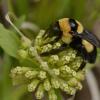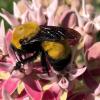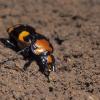
(Plecoptera: Capniidae)
Capnia lineata is small winter stone fly endemic to northwestern Idaho. It is known primarily from a few streams near Troy, Idaho in Latah County, including Little Boulder Creek. This species’ limited habitat may be threatened with degradation from extensive recreational use in the region from which it is known. Global climate change could also threaten this species’ habitat in the long-term. Research should focus on determining the true distribution of this species, the status and size of existing populations, and the potential presence of additional populations at suitable habitat in the region. Assessment and strengthening of current management practices for known habitat would also be beneficial.
Adult females are larger than males; their bodies are 7-8 mm (0.28-0.31 in.) in length, as are their forewings. Females have a small, reduced medial bridge between the 7th and 8th abdominal segments that appears embedded in the intersegmental membrane, a diagnostic characteristic that helps separate them from other closely related species. Males are brachypterous, i.e. they have extremely reduced wings. The forewings are so small that they have no apparent veins, and the hindwings are reduced even further (Hanson 1943). Male C. lineata most closely resemble the related species C. confusa, but they can be distinguished by their brachypterous wings and aspects of the epiproct (male intromittent organ). The epiproct of C. lineata resembles a simple tube of uniform width when viewed laterally, and is relatively long, reaching to the anterior edge of the 9th abdominal segment when viewed dorsally (from above) or laterally (Nelson & Baumann 1989). Nymphs have only been described for a few of the North American species in this genus, but Capnia nymphs differ from other Capniidae in having notches halfway along the inner margins of the hind wingpads, and they lack the deep serrations at the base of the ventral tooth of the right mandible seen in other genera in this family (Stewart & Stark, 2002).
Taxonomic status
Capnia lineata Hanson 1943. The taxonomic status of this species is accepted as valid. Capnia lineata and C. zukeli (Idaho snowfly) were once thought to be synonyms (Baumann et al. 1977), as the original descriptions and accompanying figures of female specimens were not adequate for separating the two species. Also, it is not uncommon for members of these two species to be collected at the same sites. However, following examination of additional female and male specimens collected at later dates, distinguishing characteristics were identified that confirmed these taxa as two distinct species (Nelson & Baumann, 1989).
The habitat requirements for nymphs of C. lineata have not been specifically documented. The life history and ecology of many species in the genus Capnia are poorly known, due to the difficulties inherent in sampling for nymphs under ice in winter, and difficulties in distinguishing between Capnia nymphs of different species. Capnia lineata occurs in creeks in northern Idaho. Species in this family require cool temperatures for development. Young nymphs hatch in early spring; as the water temperatures rise they move into the hyporheic zone (a zone of loose rocky substrate under the stream saturated with water) and undergo diapause, becoming inactive until the water cools in late fall and winter, at time they feed and grow rapidly to maturity. Specific feeding behavior of C. lineata nymphs has not been observed, but most species in this family feed by shredding detritus (Merritt et al. 2008).
Many adults in this genus emerge in late winter or early spring. Capnia lineata emerges relatively late compared to other Capnia species, and adults have been collected from late February to late June (Nelson & Baumann 1989). Species in this family are usually univoltine, with one generation per year.
Capnia lineata has been collected from nine creeks in the area of Troy, Idaho, in Latah County in the northern portion of the state, including Little Boulder Creek at Little Boulder Creek Campground in the Clearwater National Forest (Nelson & Baumann 1989).
This species was reported from a single site in California by Jewett (1960), although Baumann confirms that Capnia lineata is endemic to Idaho and does not occur in California (S. Foltz Jordan, pers. comm. with. R. Baumann, December 2009).
The habitat requirements for nymphs of C. lineata have not been specifically documented.
Canada – Species at Risk Act: N/A
Canada – provincial status: N/A
Mexico: N/A
USA – Endangered Species Act: N/A
USA – state status: Idaho S1 Critically imperiled; California SNR Not ranked
NatureServe: G3 Vulnerable
IUCN Red List: N/A
Capnia lineata currently receives no federal protection. It is considered a Species of Greatest Conservation Need (SGN) by the Idaho Natural Heritage Program.
Capnia lineata is a rare endemic species with restricted habitat, limited populations, and unknown dispersal ability. This species is known reliably from a handful of small streams in a single county in northern Idaho. One of those streams, Little Boulder Creek, is on the EPA list of impaired (303(d)) waters from source to mouth, due to sediment and siltation. Sedimentation could lower water quality and clog the spaces in the hyporheic zone where young larvae diapause during warm weather, increasing larval mortality. Habitat quality could also be impaired by extensive recreational use, as mountain biking, hiking, camping, fishing, ORV usage, and scenic driving are popular activities in the area.
Capnia lineata was mentioned as a species that could be negatively impacted by a proposed highway extension (Thorncreek Road to Moscow Project) that would change an existing undivided 2-lane road into a divided 4-lane highway. This project will affect several streams and drainages and potentially up to 7 acres of potential C. lineata habitat. The environmental assessment associated with the project stated the cumulative impacts on C. lineata would be negligible (Idaho Fish and Game 2006).
Additional potential threats such as the effects of disease and predation have not been assessed. However, such small isolated populations are extremely vulnerable to stochastic events, and are generally at greater risk of extirpation from normal population fluctuations due to predation, disease, and changing food supply, as well as from natural disasters such as floods or droughts. They may also experience a loss of genetic variability and reduced fitness due to the unavoidable inbreeding that occurs in such small populations.
Global climate change could also pose a long-term threat to C. lineata. Assessment of climate change trends in North America has already revealed changes in precipitation patterns, stream hydrology, and plant bloom time. Overall, annual mean air temperature increased in North America from 1955-2005, and total annual flow has decreased in many streams in the central Rocky Mountain region throughout the past century at an average rate of 0.2% per year (Rood et al. 2005). The effects of global climate change are projected to include warming in the western mountains, causing snowpack and ice to melt earlier in the season (Field et al. 2007). This could lead to increased flooding early in the spring and drier summer conditions, particularly in arid western areas where snowmelt sustains stream flows. Spring and summer snow cover has already been documented as decreasing in the western United States, and drought has become more frequent and intense (Intergovernmental Panel on Climate Change 2007). Floods and droughts are projected to increase in frequency and intensity; erosion is also projected to increase due to decreased soil stability from higher temperatures and reduced soil moisture, and increases in winds and high intensity storms. As a species that requires cool temperatures for development, the survival of C. lineata could be threatened by habitat impairment due to global warming, including increased frequency and severity of seasonal flooding and droughts, reduced snowpack to sustain stream flow, increased erosion and siltation, and increasing air and water temperatures.
The Idaho Comprehensive Wildlife Conservation Strategy (2005) states that no population trend data is available for this species. Additional surveys to establish these parameters would be beneficial. Necessary actions include monitoring known populations and searching for new ones, and protecting habitat in regions where the species is known to occur.
Little is known about the biology or dispersal ability of this species. Research into life history and habitat management in the area would be valuable. Additional surveys should be conducted in California in the area from which this species was reported previously to determine if a disjunct population of C. lineata is present or if this species is endemic only to Idaho.
Baumann, R. W., Gaufin, A. R., and Surdick, R. F. 1977. The stoneflies (Plecoptera) of the Rocky Mountains. Memoirs of the American Entomological Society 31: 207 p.
Field, C.B., Mortsch, L.D., Brklacich, M., Forbes, D.L., Kovacs, P., Patz, J.A., Running, S.W. and Scott, M.J. 2007. Chapter 14: North America. In: Climate Change 2007: Impacts, Adaptation and Vulnerability. Contribution of Working Group II to the Fourth Assessment Report of the Intergovernmental Panel on Climate Change (Parry, M.L., Canziani, O.F., Palutikof, J.P., van der Linden, P.J. and Hanson, C.E., eds.). Cambridge University Press, Cambridge, UK.
Hanson, J. H. 1943. Descriptions of new North American Plecoptera. II. Proceedings of the Entomological Society of Washington 54(4):85-88.
Idaho Fish and Game. 2006. General wildlife assessment, Thorncreek Road to Moscow. Project Number: DHP-NH-4110 (156), Key Number: 9294. 29 pp.
Idaho Fish and Game. 2005. Idaho Comprehensive Wildlife Conservation Strategy, Appendix F: Species Accounts and Distribution Maps for Idaho Species of Greatest Conservation Need.
Intergovernmental Panel on Climate Change. 2007. Summary for Policymakers. In: Climate Change 2007: Impacts, Adaptation and Vulnerability. Contribution of Working Group II to the Fourth Assessment Report of the Intergovernmental Panel on Climate Change (Parry, M.L., Canziani, O.F., Palutikof, J.P., van der Linden, P.J. and Hanson, C.E., eds.). Cambridge University Press, Cambridge, UK.
Jewett Jr., S. J. 1960. The stoneflies (Plecoptera) of California. Bulletin of the California Insect Survey 6(6):1-57.
Merritt, R. W., Cummins, K. W., and Berg, M. B. (eds). 2008. An Introduction to the Aquatic Insects of North America. 4th edition. Kendall/Hunt Publishing Company, Dubuque, Iowa.1158 pp.
Nelson, C. R., and Baumann, R. W. 1989. Systematics and distribution of the winter stonefly genus Capnia (Plecoptera: Capniidae) in North America. Great Basin Naturalist 49(3):289-363
Rood, S.B., Samuelson, G.M., Weber, J.K., and Wywrot, K.A. 2005. Twentieth-century decline in streamflows from the hydrographic apex of North America. Journal of Hydrology 306:215- 233.
Stagliano, D., M., Stephens, G. M., and Bosworth, W. R. 2007. Aquatic Invertebrate Species of Concern on USFS Northern Region Lands. Report to USDA Forest Service, Northern Region. Montana Natural Heritage Program, Helena, Montana and Idaho Conservation Data Center, Boise, Idaho. 95 pp. plus appendices.
Stewart, K. W. and Stark, B. P. 2002. Nymphs of North American stonefly genera (Plecoptera), 2nd ed. The Caddis Press, Columbia OH. 510 pp.
Additional Resources
Nature Serve Explorer (Accessed March 2008)
Profile prepared by Celeste Mazzacano, The Xerces Society for Invertebrate Conservation





